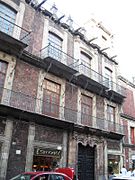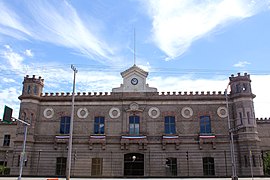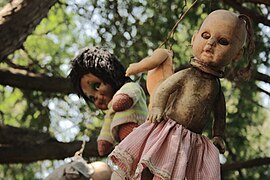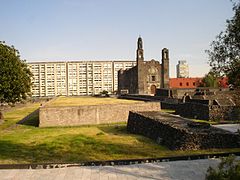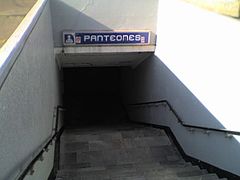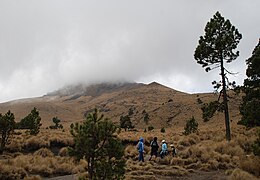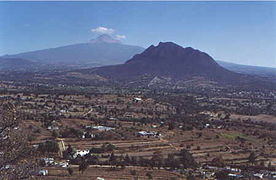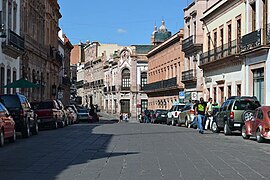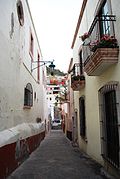List of reportedly haunted locations in Mexico
Appearance
The following is a list of reportedly haunted locations in Mexico.
Baja California
- Agua Caliente Casino and Hotel in Tijuana: This former casino, which is now a high school, is allegedly haunted by a female singer who poisoned her lover after stealing money from him in the 1930s. According to legend, the man pursued her in an attempt to get the antidote, but she refused to give it to him, and he shot her to death in his frustration.[1]
Baja California Sur
- Colegio Salvatierra in Santa Rosalía, Baja California Sur: According to legend, there was a student, a small child, who used to play with marbles in the girls bathroom. One day he accidentally swallowed a marble and choked. After teachers took out the body, girls who enter the bathroom have said that they heard noises of laughter and a child playing with marbles, and some have said they have seen marbles roll into the bathhouses.[2]
- Hotel California in Todos los Santos, Baja California Sur: founded in 1948, supposedly several entities haunted the courtyard of this inn.[3]
- Hotel Finnestera in Cabo San Lucas: The ghost of a maid, as well as voices are allegedly encountered.[1]
Chihuahua
- Restaurant La Casona in Chihuahua, Chihuahua: is a mansion built from 1888 to 1893, supposedly at least 5 ghosts inhabit it. The former and the most active is a boy, usually appears playing with a blue ball in the staircase, according to the legend he was son of the first house owner, the General Luis Terrazas. Other spirits are a little girl, a little boy with a sailor suit, a lady of white and other lady of black.[4][5]
Durango

- Mapimí Silent Zone in Bolsón de Mapimí, Durango: is a legendary site of paranormal phenoms, allegedly in the site appears orbs and a tall blond man, also several alleged ufological phenoms as ovnis and allien like creatures reportedly were viewed in the site.[6]
Guanajuato
- Callejón del beso ("The Alley of Kiss") in Guanajuato, Guanajuato: allegedly haunted by two lovers who died in tragic circumstances here.[7][8]
- Casa de la tía Aura ("House of Aunt Aura") in Guanajuato, Guanajuato: was built in 1805. During the 1840s, two women were murdered in the property by their own father, the first daughter was walled in the basement when he knew that she got pregnant without being married and the second was poisoned after to inherit all. People say that they can hear voices and see orbs and shadows in the house. The house is now a museum.[9]
- Casa de las Brujas, or the House of the Witches, in Guanajuato, was built in 1845, and was owned by a Dutch mine owner by the name of Juan Carson. He was imprisoned for murder, and his daughter, Susan, was left in the custody of her aunts in the house. She was supposedly found beaten and starved to death in the cellar a year later. According to legend, Susan's ghost is said to haunt the house, and odd sounds and cold spots have been reported.[1]
- Hotel San Diego in Guanajuato: According to legend, there is a room on the hotel's top floor where sounds of doors slamming and furniture moving around can be heard.[1]
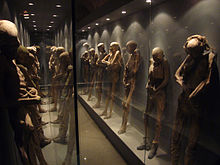
- House of Laments or Casa de los lamentos in Guanajuato, Guanajuato: This mansion was the house of a serial killer active during the 1890s through the 1910s named Tadeo Fulgencío Mejía. According to the legend, the victims' crying sounds can be heard in the mansion.[10]
- House of mummies in Guanajuato, Guanajuato: is a museum where the natural mummies of Santa Paula cemetery are in exhibition. In this place several paranormal phenomenon have been reported such as an apparition of a tall lady, cries of babies and other strange whispering sounds.[11]
Jalisco
- Panteón de Belén (Belen Cemetery): Located in the center of Guadalajara, it was opened in 1848. According to local legend several entities appear here and many mysteries surround the cemetery, including "The Vampire Tree" and the much visited tomb of "Nachito".[12]
- Clover Lawn House or Casa del Trébol Negro in Guadalajara, Jalisco: was built in 1908. Reputed to be haunted by a family father and who murdered his wife and daughter in the house. Supposedly, the ghosts wander throughout the property; bloody marks appear in the room walls; crying, shouting and voices are heard in the house.[13][14]

- Hospicio Cabañas in Guadalajara, Jalisco: was built from 1805 to 1810, during its history the building was an asylum, military barracks, prison and orphanage. According to the legend several ghosts haunt it, mainly children spirits who wander in the building. Also supposedly it had a monumental clock installed in 1952. The clock mysteriously stopped whenever a child died in the orphanage.[15][16]
- Hospital Fray Antonio Alcalde y Barriga in Guadalajara: Opened in 1788 and still in function. Supposedly, several paranormal entities appear in the hospital, the most active is a 19th-century female nurse named Manuela Lozano, who wanders for the Internal Medicine wing.[17][18]
- Journalism Museum, also known as La Casa de los Perros or The House of the Dogs: Located in the center of Guadalajara, is a colonial mansion that in the 1790s housed the first independent newspaper of America. The hauntings are attributed to the original owner's wife, who took on a lover and later conspired to kill her husband.[19][20]
Mexico City
- Mexico City International Airport in Venustiano Carranza, Mexico City: allegedly haunted by a little girl who often appears playing with a ball and interacts with people. She asks them to tie her shoelace then disappears. Supposedly the ghost was filmed, and the video can be seen on YouTube.[21]
- Callejón del Aguacate in Coyoacán, Mexico City: Is the site of esoteric rituals,[22] and according to testimony, an entity wanders by this backstreet.[23]
- Casa de la tía Toña ("Aunt Toña´s House") in Chapultepec, Mexico City: Several fatal accidents were reported in the property. Also, according to legend the first owner lady and her adopted children dead by she haunted the mansion.[24]
- Casa de las Brujas or the Rio de Janeiro building in Colonia Roma, Mexico City: was built in 1908. During the first part of the 20th century, a woman named Bárbara Guerrero also known as "Pachita" lived here. The legend says that she practiced witchcraft, supposedly several paranormal phenomenons occurring in the house including the appearance of the Barbara Guerrero ghost.[25][26]
- Casa de los Condes de la Torre Cossío y de la Cortina , or the House of the Count De la Torre y la Cortina, in Historic center of Mexico City: A colonial mansion, which during the 1630s, a spree killer named Juan Manuel de Solórzano lived there. Believing his wife unfaithful, he killed several men, simply because they walked outside to his house. Juan Manuel would ask them the time, if they responded 11 pm, or showed anxiety, he would stab them. He was executed in 1641.[27] The legend says that a man with 1600s-era clothing wanders in and around the house, sometimes asking bystanders for the time, and soon after disappearing.[28]
- Casa Negra ("Black House") in Álvaro Obregón, D.F.: is XIX century mansion, now abandoned. According to the legend, its firsts owners- a family named Mondragón- died of unknown causes into the house; without a live heir, the property passed to State custody. Supposedly for the paranormal phenomena, the house is uninhabitable. Allegedly paranormal activity in the site including temperature changes, voices and bizarre sounds, doors open and close alone and invisibles hands that touching and pulling.[29]
- Hospital Juarez in Gustavo A. Madero, Mexico City: open in 1847 and still in functions. Here started one of the most famous Mexican ghost story, the legend of La Planchada, a spirit of an early 20th-century female nurse who haunts this hospital.[30] Also reported this ghost was sight in several other hospitals around Mexico.
- Instituto Cultural La Moira in San Miguel Chapultepec, Miguel Hidalgo, D.F.: according to the legend this house is haunted by several paranormal entities, the most active is a young man named Marcos who died under mysterious circumstances during the 1960s, allegedly when he was an 8-year-old boy who entered the building, at this time abandoned, and he saw an apparition, a man hanged in one of the rooms; 10 years after he appeared hanged in this same room in an apparent suicide. Several spiritism sessions done in the site since this time, allegedly the paranormal phenoms reported in the houses included from shadows, strange sounds and orbs to objects moving alone, people who say had visions and demoniac possessions. According with some parapsychologists this house´s the most haunted in Mexico.[31][32][33]
- Mexico City Metro: opened to the public in 1969, allegedly several entities haunted its installations, mainly persons who committed suicides. According to the legend, the Tasqueña station is one of the haunted place into the train web, in this place supposedly an old man appears at nights for to accompany to lonely passers, the man would be murdered during assault for this reason wants to protect to the people. Other haunted stations are the Pino Suárez station where appears an old employee named Victor Castilla Platonoff who died in the site in 1989 and apparently doesn't know that he has been dead and also an ancient Aztec man who cries for the Spanish Conquest;[34] the Panteones station where the people say that they can hear knocks in the tunnel walls that connects this station and the next and shadow "lumps" a few feet ahead that disappear as they get close – the paranormal activity in this place is attributable to its proximity to two old graveyards, the Spanish and the British graveyards;[35][36] - the Airport station where appears a little girl who plays with her own decapitated head; and the Viaducto station where happened in 1975 the worst subway accident in the Mexico history with at least 31 deaths, supposedly from then a ghost train walks from Allende station to Zocalo station, the same route that the accident train.[37]
- Palace of the Inquisition in the Historic center of Mexico City: Constructed between 1732 and 1736, was the place of the New Spain Tribunal of the Holy Inquisition until 1820 when it was disbanded. Supposedly, the construction is place of several paranormal phenomenons.[38][39]
- Palacio de Lecumberri in Venustiano Carranza, Mexico City: Constructed in 1900, it served as a prison for 76 years.[40] Supposedly several entities live in the building, but two are the most active. the first is a male spirit, which wanders throughout the building, wanting to interact with people. Reportedly, he would say "My name's Jacinto" or "Again, Amalia didn't come here" and disappear.[41] The second is also a male spirit, dressed in a black charro costume, which is especially aggressive, and has appeared to many people.[42]
- Pateón de San Isidro in Azcapotzalco, Mexico City: is a cemetery exclusive for children, according with the legends several entities appears in the site but two are the most active, the first is a little girl named "Nani", she appears in a street next to the cemetery, causes automovilistico accidents because she often distracts to the drivers. The second, is a boy named "David" who often interacts with the person.[43]
- Plaza de las Tres Culturas or Plaza de Tlatelolco in Cuauhtémoc, Mexico City: the history of this place dated to before XV century, in this time several tragical events happened in the place. In Pre-Columbian era, it was the most important market in Mesoamerica but also public execution place.[44] During Spanish conquest of Mexico several natives massacres occurred here, included 4 000 deaths on 13 August 1521. Contemporary bloody events as the Tlatelolco massacre in 1968 and the Nuevo León building collapse during 1985 Mexico City earthquake, with at least 400 fatality victims, also occurred here.[45] Stories of ghosts in this place are counted from Aztecs time.[46] The paranormal phenomena reported here are sounds of children playing, the 1968 massacre sounds[47] and shadows moving from Foreign Relations building to the church.[48]
- Posada del Sol in Colonia Doctores, Mexico City: was an ambitious inn project during the 1950s. For several mishaps it was never completed. Finally, the owner - named Fernando Saldaña - committed suicide in the site in 1945. According to the legend, he cursed the property for it will be never inhabited. After of the Saldaña death, the building became by turns a home to the Instituto Indigenista Americano, El Consejo de Recursos Minerales and the Procuraduría General de Justicia, but always it was abandoned. Alleged the Saldaña ghost still haunts the lonely building.[49]
- Swamp South of Mexico City: The Island of Dolls is rumoured to be one of the most haunted sites in Mexico. Don Julian Santana was a man who lived as a hermit on this island for over fifty years, where he is believed to have lost his mind. The tragic accident of a girl who drowned on the island while visiting caused further madness in Julian. The island was turned into a shrine for that little girl. Dolls by the hundreds hang in the trees and the house. Each of the dolls is believed to be fused with the energy of the little girl. Candles, hard candy, and dolls are occasionally brought as offerings to appease the spirits. The dolls are said to move, beckon, and speak to those who come. The man's spectre also roams this place. Orbs, loud sounds, and reports of doll eyes opening abound.[1]
- Haunted places in Mexico City
-
Casa de los Condes de la Torre Cossío y de la Cortina.
-
Palace of Inquisition.
-
Palacio de Lecumberri.
-
Dolls in the Xochimilco Dolls′ Island.
-
Plaza de las Tres Culturas, Tlatelolco.
-
Entrance to Panteones station subway.
Nuevo Leon
- Casa de Aramberri in Monterrey: Reputed to be haunted by a man's wife and daughter, who, according to legend, were tortured to death by three male robbers in 1933.[1]
- Casa de los Tubos in Monterrey, Nuevo Leon: An abandoned mansion built during the 1970s, reputed to be haunted by a girl that committed suicide in the property and a boy that died in an accident.[50]
- Villa de Santiago, Puerto Genovevo: These mountainous roads have been the site of many car accidents. Among the numerous crosses, there is a set of ten crosses in memory of a family who were the victims of a truck accident. If one stands next to the crosses, it is rumored to be possible to see a truck moving very fast through the trees. Also, it is said that at midnight the screams and pain of those in the accident can be heard.[1]
Oaxaca
- Jarquin in Mietchulan, Oaxaca: This small store is haunted by its anonymous former owner. The owner's apparition is known to walk in and out of the building. He is notorious for pushing customers out of the store.[51]
Puebla
- Chautla Hacienda in Puebla, Puebla: opened in 1777, was an agave plantation and actually it is an inn. Allegedly this site is haunted for several entities, the ghosts of a horseman and a boy were filmed in the site.[52]
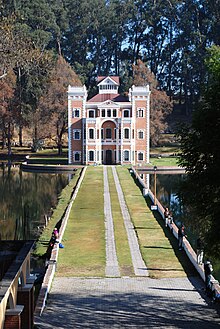
- Instituto Cultural Poblano in Puebla, Puebla: built from 1740 to 1751. It was a Society of Jesus convent to 1767. After it served as cemetery during the Typhus epidemic of 1812–1813. From 1840 to 1871, the property was conditioned as a prison; the Penitentiary of Puebla was in functions to 1984, when it became a cultural center and museum.[53] Allegedly the building is haunted for many ghosts of the different stages.[54][55]
- Santa Mónica Religious Art Museum in Puebla, Puebla: built in 1606 as poorhouse and orphanage. From 1686 to 1934, it served as Augustinian Recollects convent.[56] The religious abandoned the building by State order, after the scandal when the cloister life condition was known.[57] According to the legend the former convent is the site of several paranormal events as the lady of white apparitions,[58] apparitions of persons with antique clothing are wandering for the installations or nonexistents clocks sound.
Queretaro
- Casa de La Zacatecana: A colonial mansion in Santiago de Querétaro, Querétaro. In the 17th century, a woman known as "La Zacatecana" commanded the murder of her husband, and then executed the killer that she contracted for the murder. The legend says that the mansion harbours three spirits.[59]
- Claudia Mijangos house: Located in a suburb of Querétaro, Claudia Mijangos killed her 3 children here in 1989. She said that "... she was possessed by a diabolic entity". To this day, neighbors claim that they can hear crying and shouting in the house and a boy appears in a window of the second level. Local government boarded the windows and built a wall around the house to deter vandalism and the curious public. Although the house is abandoned and unclaimed by any immediate family members, it is not known if Claudia Mijangos will re-occupy the house upon release in 2014. The home was a subject of investigation by the Mexican paranormal television program, Extranormal.[60]
San Luis Potosi
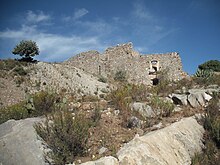
- Real de Catorce in Sierra de Catorce, San Luis Potosí: is a ghost town founded in 1770 and abandoned in 1920,[61] supposedly the town is haunted. According to the legend one of the most active ghost is an ancient miner known as "El Jergas", he´s a benevolent entity who guided miners to new silver veins.[62]
Sonora
- Los Estralios Mines in San Carlos Nuevo Guaymas, Guaymas: is alleged to be inhabited by a demon or a werewolf called "Neuale".[63]
State of Mexico
- Lake Texcoco in Texcoco, State of Mexico: A murderous monster was said to live in the depths of this lake. The name of such beast is Ahuizotl. It was a canine mammal with spiky hair and a hand in the tip of its long tail. It was supposed to eat humans. In order to attract people, it would produce a sound like that of an abandoned human baby crying. Its victims were caught by it and then drown in the lake. In Aztec mythology the souls of its victims were sent to Tlalocan.[64][65][66]
- Lerma Marshes in San Miguel Almaya: A mermaid is said to live in the lakes and swamps. Her name is Tlanchana. She comes out of the marshes once or twice a year. She is beautiful and attractive. If a man follows her he dies.[67][68]
- Pilar Hacienda in San Juan Teotihuacán: was built by the Spaniards who came to Mexico in the 16th century. On the top floor there is a large cut on the window, which is believed to be the mark of Miguel Aritztia, a Spanish hidalgo. It is thought that he died from falling off the balcony, and while he fell he grabbed at the window, creating the long scratch. The ghost of the wife of Miguel has also been seen on the balcony crying "Oh, my husband." She was there at the time of his death, and tried to save him. Mr. Aritztia has been reported to be seen hanging from the window, as well as being seen in a window. It is said that at times the scratch disappears from the window.[69]
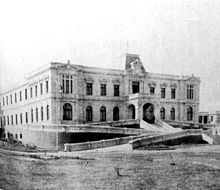
- General Asylum La Castañeda or Psychiatric Hospital La Castañeda now only exist the central building in Amecameca: It was the biggest madhouse in Mexico, opened in Mexico City during 1910, was active for 58 years and during this time is said to have housed around 60 000 patients. Several paranormal cases have been reported in the hospital.[70]
Tlaxcala
- Matlalcueitl volcano and Cuatlapanga mount in La Malinche National Park: supposedly a reptilian monster lived in the Matlalcueitl mountain and that would come down during the rainy season to abduct children and take them up the mountain to be devoured.[71] Other legend says that in Cualtlapanga sounds a golden bell hidden there during the Mexican War of Independence. Many people looked for it but no one found it.[72]
- Haunted mounts in La Malinche National Park
-
Matlalcueitl or Malinche volcano
-
Cuatlapanga mount.
Veracruz
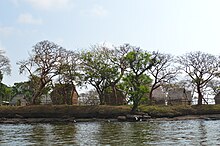
- Catemaco in Catemaco Municipality, Veracruz: internationally known as the "Capital of wizards", the history of this city dated from XVII century. Each March, from 1774, the city celebrates the Night of witches, when witchcraft practitioners and believers gather for to celebrate ancient rituals.[73][74] Several legends are counted in the site, as the legend of Cerro del Mono Blanco (White Monkey mount) where supposedly a man named Gonzalo Aguirre Pech, known as the "Great Wizard", sold his soul to the Demon.[75]
Yucatan
- Cecilio Chi Elementary School in Espita, Yucatán: According to a legend, there was a rancher who was a powerful warlock. He was able to obtain any vegetable or fruit from his farm regardless of the time of the year. Furthermore, he could get them in 1 day. That is not enough time for crops or trees to grow. It was rumoured that he was able to transform into a sinister flying monster known as the Uay Pop. After the suspected shapeshifter died it was said that the Uay Pop haunted the same place were the farm was found.[76]
- Cenote Zací in Valladolid, Yucatán: local legends say that the cenote is haunted for several ghosts, mainly ancient Mayan persons who were sacrificed in the site. The most antique legend of ghosts relates that two lovers named Hul-Kin and Sac-Nicte committed suicide here, they jumped it into the cavern. Allegeldy paranormal phenomenons in the site included bizarre sounds, voices and cryings, and the apparition of an ancient Mayan warrior.[77][78]
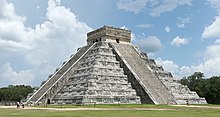
- Chichen Itza in Tinúm, Yucatán: is an ancient Mayan city, according with some testimonies the site is haunted by several entities, from ancient ghosts of sacrificed persons[79] and Aluxes – fairy-like spirits in Mayan folklore –[80] to aliens.[81]
- Cholul Hacienda in Mérida, Yucatán: was a 19th-century henequen plantantion, now abandoned. According to the legend several ancient owners of the plantation practiced witchcraft and Satanism, one of them appears with owl form.[82] Other appearances were human shadows in the windows, a woman with a baby crying [83] and an antique plantation laborer than committed suicide after to kill the rapist of his fiancee.[84]
- Hospital Peninsular in Merida, Yucatan: was a hospital that operated as illegal abortion clinic to 2009 when was closed. According with popular testimonies the firsts alleged paranormal events reported in the site occurred in 2007, when the hospital was partially abandoned already, a policeman group entered it one night, they affirmed that heard babies crying, their lamps stopped to function and some doors opened and closed alone.[85]
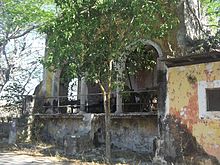
- Minesbalam Hacienda and Village in Progreso, Yucatan: is an abandoned 19th-century henequen plantation, around it was a village of about 2000 people. Supposedly, the witchcraft and the public executions were usual there. The most active ghost in the property is a boy named "Julian", he committed suicide after being raped, during the 1920s.[86][87] Also the legend says, in the place can see it some Mexican folklore demons as the Xtabay and chaneque.[88]
- Wyndham Mérida′s Inn in Mérida, Yucatan: allegedly several entities haunted the building. According with employees testimonies the most active is an old man who supposedly was buried in the property before to the inn construction.[89]
Zacatecas
- Meson de Jobito Hotel in Zacatecas, Zacatecas: Built in 1700, then it was an inn, during the 1940s it was adapted for to be condominiums. From 1990 to 1993, the building become in the now hotel.[90] Supposedly the hotel is one of the most haunted in the country. Reported paranormal phenomenons in the site included the feeling to break observed, children voices and laughters, these invisible children jumping on the beds, horses sounds and objects moved alone. This paranormal activity concentrates in the 107 room.[91][92][93]
- Historic Center of Zacatecas in Zacatecas, Zacatecas: This World Heritage Site has many legends. One of the most popular is the legend of "Calle de las tres cruces", here in 1761 two lovers— named Gabriel García and Beatriz Moncada— died in tragic circumstances, the legend says that the lovers ghosts appears in this street.[94] Calle de las tres cruces is on Hidalgo avenue where this finish with Toledo street [95] Other legend tells about a haunted backstreet named "Callejón del indio triste" where Xolotl one of the last Chichimeca natives leader died during the 1550s.[96] Another alleged haunted backstreet is known as "Callejón del mono prieto", where according to the legend, in the 17th century, here died a woman named Marciana Castillo, the people believed that she practiced witchcraft and was responsible for a child disappear and the mother death, and therefore she lived isolated her last days, died burned alive when her house caught fire.[97]
- Haunted places in Zacatecas, Zacatecas
-
Hidalgo av.
-
Callejón del indio triste
References
- ^ a b c d e f g "Hauntednorthamerica.com". hauntednorthamerica.com. Archived from the original on December 28, 2014. Retrieved 11 February 2015.
{{cite web}}: Unknown parameter|deadurl=ignored (|url-status=suggested) (help) - ^ experiences of students in the school
- ^ "Hotel California. History". hotelcalifornia.com. Retrieved 21 September 2015.
Countless stories and firsthand witnesses relating to spirits and ghosts in the courtyard of the hotel. The simple fact that the Hotel California in Todos Santos was built in 1948 which was of course far before the "Hippie" or "Classic Rock" eras
- ^ "4 lugares para festejar el Día de Muertos en serio" [4 places for really to celebrate the Day of the Dead]. Diario Crítica (in Spanish). Nayarit, Mexico. 31 October 2012. Retrieved 28 December 2014.
- ^ Rivas Medina, Vanessa (16 March 2011). "Fantasmas en La Casona" [Ghosts in La Casona]. El Heraldo de Chihuahua (in Spanish). Chihuahua, Mexico. Retrieved 28 December 2014.
- ^ Hawkes, Logan. "Haunted Mexico". Mexico Less Traveled.com. Lost Planet Media. Retrieved 24 June 2015.
Near Caballos in Durango State is the Area 57 of Mexico. This area is called "The Dead Zone" because a group of oil company workers searching for drilling sites found that no radio or TV communication could be transmitted here. Also called "Mar de Tetys", electromagnetic waves are blamed for the anomaly. Multicolored balls of light, alien like creatures, and the apparition of a tall fair haired man have been reportedly seen here.
- ^ Plazuela, Angeles. "Callejon del beso - The Alley of Kiss". travelbymexico.com. Travel By México SA CV. Retrieved 25 March 2016.
- ^ "Guanajuato legends: El callejón del beso". Don Quijote.org. don Quijote Salamanca S.L. Retrieved 25 March 2016.
- ^ Reyna, Hugo (1 November 2012). "La casa de la tía Aura" [The House of Aunt Aura]. En Línea Directa (in Spanish). Tamaulipas, Mexico. Retrieved 24 December 2014.
- ^ Enciso, Alejandra (2011-06-16). "Tragedia en Casa de los Lamentos" (Press release). Mexico: TV Azteca. Retrieved 12 December 2013.
- ^ Hawkes, Logan. "Haunted Mexico". Mexico Less Traveled.com. Lost Planet Media. Retrieved 24 June 2015.
Then there is the true tale about the so-called "House of Mummies" in Guanajuato. The greedy operators who operate the adjoining cemetery and catacombs of the dead beneath the city charge families of the dead rent to keep their loved ones buried. If there's no one who can or will pay the fee, they dig the body up and prop him or her in the adjoining "museum" where they then charge tourists to come in and look. The dry climate and properties of the soil mummify the corpses, and thus - instant museum show! Not surprisingly, there are ghost stories, including the cries of babies, an apparition of a "tall" lady, and strange whispering sounds.
- ^ "Panteon de Belen. Haunted Cemetery Legends". Explore-Guadalajara.com.
- ^ "El terror en la Mansión Clover" [The terror in the Clover Mansion]. El Informador (in Spanish). Jalisco, Mexico. 24 October 2014. Retrieved 24 December 2014.
- ^ Encizo, Silvia (Conductor). Del Arco, Alberto (Reporter). Rivas, Laura (Medium). (30 September 2009). Extranormal - La Casa del Trébol Negro (parte 1 de 2) [Extranormal - The Clover Lawn Masion (part 1 of 2)] (Television production) (in Spanish). Guadalajara, Jalisco, Mexico: TV Azteca. Retrieved 24 December 2014.
- ^ Gómez, Omar (2 February 2002). "Leyendas populares" [Popular legends]. El Informador (in Spanish). Jalisco, Mexico. Retrieved 28 December 2014.
- ^ Mauleón Lee, Monserrat (1 September 2013). "El Cabañas, sus niños, su reloj y una charla con el demonio" [The Cabañas, its children, its clock and a chat with the Demon.]. Milenio Diario (in Spanish). Jalisco, Mexico. Retrieved 28 December 2014.
- ^ Rello, Maricarmen (1 September 2013). "Almas que velan por enfermos del viejo Hospital Civil" [Souls who look after sick of the old Civil Hospital]. Milenio Diario (in Spanish). Jalisco, Mexico. Retrieved 24 December 2014.
- ^ Camacho, América (29 October 2012). "La misteriosa "Casa de los Perros" y su leyenda" [The mysterious "House of the dogs" and its legend]. UNION Jalisco (in Spanish). Jalisco, Mexico. Retrieved 24 December 2014.
- ^ "Journal museum". GDL Tours.
- ^ Pagano, Gerardo. "La leyenda de la casa de los perros". Leyendas.about.com. Retrieved 11 November 2013.
- ^ Castillo, Diego (30 October 2015). "Las niñas fantasmas del Aeropuerto de la Ciudad de México" [The ghosts girls of Mexico City Airport] (in Spanish). Retrieved 14 November 2015.
- ^ Wright, Anthony (2012-03-12). "Mexico City legends: City of ghosts". Mexconnect. Anthony Wright. Retrieved 12 December 2013.
- ^ "Lugares embrujados en el DF para visitar en Halloween". Terra. Terra Networks Mexico. 2013-10-06. Retrieved 12 December 2013.
- ^ Brito, Alberto (1 November 2013). "Fantasmas de la Ciudad: La misteriosa casa de La Tía Toña" [City Ghosts: The mysterious house of aunt Toña]. El Gráfico (in Spanish). Mexico City, Mexico. Retrieved 24 December 2014.
- ^ Caracheo, Elizabeth (18 June 2014). "La Casa de las Brujas en la colonia Roma" [The House of Witches in Colonia Roma]. Metros Cúbicos (in Spanish). Mexico City, Mexico. Retrieved 24 December 2014.
- ^ Revelo, Gabriel (29 October 2013). "Casas embrujadas del DF" [Haunted houses of Mexico City]. Sopitas.com (in Spanish). Mexico City, Mexico. Retrieved 24 December 2014.
- ^ Argueta, Germán (November 25, 2010). "Leyenda de don Juan Manuel de Solórzano". ciudadanosenred.com.mx. Retrieved 8 November 2013.
- ^ "Los Fantasmas de la Ciudad de México: Los asesinatos en la Calle de Don Juan Manuel". MX-DF. October 31, 2012. Retrieved 8 November 2013.
- ^ Delgado, Rodrigo. "Los Fantasmas de la Ciudad de México: La Casa Negra de la Colonia Roma" [The Ghosts of Mexico City: The Casa Negra of Colonia Roma]. MX-DF.net (in Spanish). MX-DF. Retrieved 28 August 2015.
...en el número 191 de Álvaro Obregón, se encuentra una impresionante casona porfiariana que, a pesar de su excelente ubicación, nunca ha podido ser rescatada del paso del tiempo; y es que, según cuentan, en este lugar se dan cita un gran número de fenómenos paranormales que han aterrado a todos los que han tratado de pasar la noche ahí. Es la llamada Casa Negra de la Colonia Roma. (...) Cuentan que, pasadas las diez de la noche el ambiente se torna pesado y la temperatura desciende drásticamente. De pronto, se empiezan a escuchar ruidos a lo largo del lugar. Las puertas empiezan a abrirse y cerrarse. Poco después, los ruidos se convierten en voces, gritos de sufrimiento. Los objetos dentro de la habitación empiezan a flotar, mientras que manos invisibles comienzan a jalarte y empujarte, como si quisieran que salgas del lugar. Nadie sabe realmente lo que pasó en la Casa Negra de Álvaro Obregón para que ésta se llenara de espíritus que quieren alejar a todos los que entran; sin embargo, una de las historias más populares dice que en este lugar vivía la familia Mondragón, una familia bien posicionada de la Ciudad de México. Un día, los padres y sus tres hijos amanecieron muertos en su cama. Nadie supo por qué o cómo habían fallecido. Fue una muerte misteriosa...
- ^ Aguirre-Santos, Adriana (22 July 2008). "La Planchada of Mexico City's Hospital Juarez". Mysterious Britain & Ireland. Ian Topham and Danny J. Parkinson. Retrieved 24 January 2015.
- ^ Revelo, Gabriel (29 October 2013). "Vagando con Sopitas.com presenta: Casas embrujadas en el D.F." [Wandering with Sopitas.com present: Haunted houses in D.F.] (in Spanish). Retrieved 26 June 2015.
- ^ Delgado, Rodrigo. "Los fantasmas de la Ciudad de México: La Moira, hogar de espíritus y demonios en San Miguel Chapultepec" [Ghosts of Mexico City: La Moira, home of spirits and demons in San Miguel Chapultepec] (in Spanish). Retrieved 26 June 2015.
- ^ "La Moira: La casa embrujada de la Ciudad de México" [La Moira: The haunted house of Mexico City] (in Spanish). 6 April 2015. Retrieved 26 June 2015.
- ^ "Los misterios del metro de la ciudad de México" [The mysteries of Mexico City subway]. chilango.com (in Spanish). Unified Digital Measurement by comScore. 28 May 2010. Retrieved 28 August 2015.
- ^ McNamee, Julie (2 February 2014). "To 10 haunted train stations". toptenz.net. © 2014 Toptenz.net. Retrieved 28 August 2015.
Panteones Metro Station, on Line 2 of the railway serving Mexico City was bound to attract stories. Its name means "Graveyards" because it was built close to two old cemeteries – and as we know from the stories above, this is very likely to lead to stories of hauntings. Panteones doesn't let us down. In the tunnel between Panteones and Tacuba stations, ghostly knocks on the walls have been heard in the pitch black, and shadowy lumps appear and disappear when workers approach them.
- ^ Madhavan, Deepu (17 April 2015). "11 Haunted Railway Stations In The World That'll Spook The Pants Off You". India Times. Indiatimes lifestyle Network. Retrieved 28 August 2015.
On the line of 2 of Mexico City's metro service is the now-infamous Panteones station. Its name refers to the two cemeteries situated in the near vicinity. Screams are often heard along the tunnels of the station apart from shadowy figures lurking in and out of dark corners and sounds of footsteps emerging out of walls.
- ^ "Los mitos más escalofriantes del metro de la Ciudad de México" (in Spanish).
- ^ "Top 10 lugares embrujados del DF" [Top 10 haunted places of Mexico City] (in Spanish). Metro Internacional. Retrieved 24 December 2014.
- ^ "Los 5 lugares más terroríficos en el DF" [The 5 most scary in Mexico City] (in Spanish). METRÓPOLI 2025. 21 October 2013. Retrieved 24 December 2014.
- ^ Flores, Daniel (December 7, 2012). "El Palacio Negro, Lecumberri". Ultra Radio. Retrieved 8 November 2013.
- ^ "Espántame panteón. 4. Palacio de Lecumberri". Chilango.com. March 28, 2013. Retrieved 8 November 2013.
- ^ Flores, Fátima (October 30, 2012). "La historia detrás del Palacio Negro de Lecumberri". Yahoo. Retrieved 8 November 2013.
- ^ "Panteón de San Isidro. Mansiones de la muerte" [Pateón de San Isidro. Masions to the death] (in Spanish). Retrieved 13 November 2015.
- ^ Saez, Juan Ramón (conductor) (2 October 2009). Los Fantasmas de Tlatelolco. Venga la Alegría [The ghosts of Tlatelolco. Venga la Alegría show.] (in Spanish). Mexico City, Mexico: TV Azteca America. Retrieved 23 August 2015.
...este lugar es trascendente en la historia porque ahí se encontraba el mercado más importante de México y de toda Mesoamérica. (...) ...a los delicuentes que se le encontraba robando como castigo y ejemplo se les cortaba las manos...
{{cite AV media}}:|archive-date=requires|archive-url=(help) - ^ Del Arco, Alberto (reporter). Elizondo, Octavio (medium). (4 February 2010). Verdadera historia de Tlatelolco. (1/2) [True history of Tlatelolco. (1/2)] (in Spanish). Mexico City, Mexico: TV Azteca America. Retrieved 23 August 2015.
{{cite AV media}}:|archive-date=requires|archive-url=(help) - ^ Saez, Juan Ramón (conductor) (2 October 2009). Los Fantasmas de Tlatelolco. Venga la Alegría [The ghosts of Tlatelolco. Venga la Alegría show.] (in Spanish). Mexico City, Mexico: TV Azteca America. Retrieved 23 August 2015.
) ...a los delicuentes que se le encontraba robando como castigo y ejemplo se les cortaba las manos, y se les obligaba deambular por el mercado con las manos amputadas como la vergüenza de Tlatelolco, muchos de ellos terminaban suicidándose dejando sus almas penando por entre los templos aztecas.
{{cite AV media}}:|archive-date=requires|archive-url=(help) - ^ Malik, Benjamín (23 August 2015). "Top 7: Fantasmas más famosos de la Ciudad de México" [Top 7: Most famous ghosts of Mexico City]. MXCITY Guía Insider (in Spanish). Unified Digital Measurement by comScore. Retrieved 23 August 2015.
...es uno de los lugares más permeados por la estela de la muerte en toda la ciudad de México. Se cuenta que por las noches es posible escuchar sonidos de niños jugando, pelotas que botan y el eco de sonidos de la masacre estudiantil.
- ^ Kruzkov (16 August 2013). "Las casas más temidas de la Ciudad de México" [The most frightening houses in Mexico City]. Identidad Geek (in Spanish). eWorks México. Retrieved 25 August 2015.
Si bien el terremoto del 85 dio pie a que muchos edificios en la actualidad se llenaran de leyendas, nada supera a los edificios de Tlatelolco, y no solo por el terremoto, sino también por la matanza de 1968, pues se dice que en el antiguo edifico de Relaciones Exteriores se ven constantemente sombras corriendo en dirección a la iglesia de ahí...
- ^ Wright, Anthony (12 March 2012). "Mexico City legends: City of ghosts". MexConnect.com. MexConnect. Retrieved 24 January 2015.
- ^ Maldonado, Jorge (31 October 2013). "La Casa de los Tubos, leyenda de Monterrey" [The Tubes House, a Monterrey legend]. Siempre 88.9 (in Spanish). Nuevo Leon, Mexico. Retrieved 24 December 2014.
- ^ corkystclaire (2013-08-18). "Ghostly World™ | Mietchulan Oaxaca Mexico". Ghostlyworld.wordpress.com. Retrieved 26 March 2014.
- ^ Carvajal, Alejandra (reporter); Del Arco, Alberto (reporter); Enciso, Silvia (compere); López, Ernesto (interviewee); Ramos, Enrique (interviewee); and Rivas, Laura (medium) (2 December 2012). Extranolmal - Hacienda de Chautla en Puebla [Extranormal - Chautla Hacienda in Puebla] (in Spanish). Puebla, Mexico: TV Azteca. Retrieved 26 June 2015.
- ^ Garcia de Loera, Fatima. "Penitenciaria porfiriana en Puebla" [Porfirian Penitentiary in Puebla]. WikiPuebla.com (in Spanish). Agencia Enfoque. Retrieved 28 December 2014.
- ^ Del Arco, Alberto (reporter); Azuara, Ariel (historian); Farcón, Ángel (medium) (30 August 2012). Extranormal. Leyendas del Instituto Cultural Poblano [Extranormal. Legends of Instituto Cultural Poblano] (TV production) (in Spanish). Puebla, Mexico: TV Azteca. Retrieved 28 December 2014.
- ^ Olguin, Sandra (24 October 2013). "4 lugares para festejar el Dia de Muertos en serie" [4 places to celebrate the Day of the deaths.]. Es Mas (in Spanish). Mexico City, Mexico: Fundación Televisa. Retrieved 28 December 2014.
- ^ "Museo de Arte Religioso de Santa Mónica" [Santa Mónica Religious Art Museum] (in Spanish). CONACULTA. 11 March 2013. Retrieved 1 January 2015.
- ^ Garcia de Loera, Fatima. "Museo de Arte Religioso" [Religious Art Museum]. WikiPuebla.com (in Spanish). Agencia Enfoque. Retrieved 1 January 2015.
El monasterio permaneció razonablemente intacto hasta el 18 de abril de 1934 en que el detective Valente Quintana descubre y da a conocer la existencia de monjas enclaustradas. Éstas se encontraban violando leyes de exclaustración por lo que una vez enteradas las autoridades correspondientes, les otorgaron 48 horas para que abandonaran el convento...
- ^ Santacruz, Luz Adriana (31 October 2014). "5 joyas de la arquitectura donde 'se respira' el miedo" [5 architectural gems when the fear "se respira".]. Obras Web.mx (in Spanish). Grupo Expansión S.A. de C.V. Retrieved 1 January 2015.
Visitantes y empleados de este lugar dicen ver cosas raras en cualquier hora del día. Varios testimonios coinciden en que se aparece una mujer que deambula vestida de blanco...
- ^ "Leyenda de la Zacatecana". Museolazacatecana.com. Retrieved 26 March 2014.
- ^ "Claudia Mijangos: la mujer que sacudió Querétaro". Ciudadypoder.com.mx. Retrieved 26 March 2014.
- ^ Arango, Doroteo (August 2015). "A Brief History of the Real de Catorce Mining District". realde14.net. © 2015 Real de Catorce. Retrieved 26 August 2015.
In 1778, Don Bernabé Antonio de Zepeda, a miner from Matehuala began to explore the Sierra de Catorce and discovered the outcrops of the rich Veta Grande, in which he sank the Guadalupe shaft that produced a great amount of red minerals along with abundant green and white silver... By 1920, Real de Catorce was nearly a ghost town and the trolley and train were removed Although ASARCO, in 1926, and Fresnillo, in 1937, evaluated the major vein structures, a resurgence of mining activity did not take place until 1942 when a small cyanide plant was constructed and operated for about ten years.
- ^ Hawkes, Logan. "Real de Catorce. Ghost town in the clouds..." Mexico Less Traveled.com. Last Planet Media. Retrieved 26 August 2015.
The town was founded around 1770 after a man named Ventura Ruiz stumbled across a rich deposit of silver while searching for his lost horse... Why the silver mines are no longer a going concern is a matter of speculation. Some say the silver simply dried up. Others say the mining 'disturbs the gods', which caused much 'bad luck'. A few say the mines are haunted. One local legend has it that a ghost (the locals call him El Jergas) leads miners away from their fellow workers underground and into remote areas of the dark mines. The outcome, however, is a good one, because apparently the phantom miner is pointing the way to another vein of silver.
- ^ "Hauntednorthamerica.com". web.archive.org. Retrieved 11 February 2015.
- ^ http://mitosmonstruosyleyendas.blogspot.mx/2014/03/ahuizotl-el-monstruo-de-agua.html.
{{cite web}}: Missing or empty|title=(help) - ^ https://www.elpensante.com/el-perro-del-mundo-subacuatico-la-leyenda-azteca-del-ahuizotl.
{{cite web}}: Missing or empty|title=(help) - ^ http://mysteriousuniverse.org/2015/01/ahuizotl-aztec-man-eating-monster-and-secret-to-longevity.
{{cite web}}: Missing or empty|title=(help) - ^ "Limitantes para el desarrollo turistico en San Miguel Almaya" (PDF). Universidad Autonoma del Estado de Mexico. 2014-01. Retrieved 29 October 2016.
{{cite web}}: Check date values in:|date=(help) - ^ http://alephedario.blogspot.mx/2015/12/sirena-es-adorada-en-capuluhac.html.
{{cite web}}: Missing or empty|title=(help) - ^ "Haunted Places in Mexico". Voices.yahoo.com. 2009-08-08. Retrieved 11 June 2012.
- ^ Emmanuel, Hery (2011). "Puertas al infierno en México". Marcianos.com.mx. Retrieved 8 November 2013.
- ^ Bowles (2012)
- ^ Alonso, Jesús (1 September 2014). "El Cuatlapanga, un volcán de leyendas en Tlaxcala" [Cualtlapanga]. Travel Report Mexico (in Spanish). Travel Report. Retrieved 1 January 2015.
- ^ Hawkes, Logan (2010). "Catemaco - The city of witches". loganhawkes.com. Lost Planet Audio Books. Retrieved 24 August 2015.
March is the perfect time for traveling to Catemaco if you want to attend the annual "Noche de Brujas", or the Night of the Witches annual celebration. In a community that prides itself in being the world's "capital of witches," the first weekend in March each year is marked by gala events, special ceremonies, and plenty of supernatural advise...
- ^ Hawkes, Logan. "Haunted Mexico". Mexico Less Traveled.com/. Lost Planet Media. Retrieved 24 August 2015.
In Mexico's World Capital City of Witches, Catemaco, just south of Veracruz, wizards and witches bark on the streets regularly. The community is home to the High Council of Wizard (Witches) who actually form a sort of cooperative as they offer their services to any and all with faith and money... Each March, a special Night of the Witches celebration is held and travelers from across Mexico and the world find themselves in a carnival atmosphere as they walk the crowded streets of this very strange town, which sits serenely on the shores of amazing and mystical Lake Catemaco. It is a world of dense jungle, beautiful waterfalls, and witches on every corner...
- ^ Valdés, Valentín (29 September 2009). "Catemaco: Tierra de brujos" [Catemaco: Land of witches]. zocalo.com.mx (in Spanish). ZÓCALO SALTILLO. Retrieved 24 August 2015.
Veinte años antes, Aguirre Pech organizaba "el turismo del brujo" en Catemaco, en una época en donde los brujos practicaban magia blanca utilizando las recetas ancestrales para la cura de males físicos y sentimentales. Aguirre Pech tomó la estafeta de "Brujo Mayor" y a partir de ahí comenzó la promoción de esta actividad que atrajo a políticos, artistas, deportistas y a la población en general. Se dice que Aguirre Pech vendió su alma al diablo en el cerro del Mono Blanco, con lo cual obtuvo poderes diabólicos bajo el mote de "El Brinco de León" hasta 1982, cuando falleció.
- ^ http://www.mayas.uady.mx/breves/enero2001.html.
{{cite web}}: Missing or empty|title=(help) - ^ http://sipse.com/milenio/enigmas-yucatan-jorge-moreno-sucesos-sobrenaturales-en-mistico-cenote-zaci-110251.html.
{{cite web}}: Missing or empty|title=(help) - ^ http://www.mexigotours.com/cenote-zaci.html.
{{cite web}}: Missing or empty|title=(help) - ^ Bert, Weiss; Klingshirn, Kristin. "Kristin's Friend Is Being Haunted By A Mayan Ghost He Picked Up From Their Trip!". The Bert Show.com. The Bert Show. Retrieved 19 March 2016.
So Kristin went on vacation with some friends to Mexico, and while they were there, they visited a Mayan temple at Chichén Itzá, where Mayan sacrifices took place. They even used to have competitions where the captain of the winning team would get beheaded as a sacrifice to the Gods; and it wasn't a bad thing…you wanted it to happen, because it was an honor. Well, Kristin's friend, Adam, thinks he might have picked up a Mayan ghost…and it doesn't seem to friendly. While they were at the temple, it was a beautiful day, but out of nowhere, the wind picked up, and a dark, ominous cloud blew in…and the picture the group took had ORBS in it...
- ^ Báalam (6 April 2009). "Los temidos Aluxes de Chichén Itzá" [The feared Aluxes of Chichen Itza]. productions.caffix.org (in Spanish). Productions Caffix. Retrieved 19 March 2016.
- ^ Moreno, Jorge (1 August 2013). "Precursor del tema ovni buscó extraterrestres en Chichén Itzá" [Precursor of UFO theme searched aliens in Chichen Itza]. sipse.com (in Spanish). Grupo SIPSE. Retrieved 19 March 2016.
...en la década de los setentas, Adamsky visitó en dos ocasiones las ruinas de Chichen Itzá en busca de evidencias de ovnis, aunque en ese entonces su visita no causó tanto revuelo.
- ^ "Hacienda embrujada de Cholul" [Haunted plantation of Cholul]. Blog Yucatán (in Spanish). Yucatan, Mexico. 26 May 2012. Retrieved 28 December 2014.
- ^ "Leyendas urbanas de la casa embrujada de Cholul" [Urban Legends of the Cholul haunted house.]. Yucatán en corto (in Spanish). Yucatán en corto. Retrieved 28 December 2014.
- ^ Cordero, Déborah (8 October 2012). "Los 5 sitios de terror que ahuyentan de Yucatán" [The 5 horror sites than scary in Yucatan.]. UN1ÓN Yucatán (in Spanish). Yucatan, Mexico. Retrieved 28 December 2014.
- ^ "Fenómeno paranormal de la ex Clínica Peninsular de Mérida" (in Spanish). 2 June 2013.
- ^ Cordero, Déborah (5 November 2012). "5 enigmas de Misnebalam, el pueblo fantasma" [5 mysteries of Misnebalam, the ghost town]. UN1ÓN Yucatán (in Spanish). Yucatan, Mexico. Retrieved 28 December 2014.
- ^ "Misnebalam, un púeblo fantasma" [Misnebalam, a ghost town]. Al Chile (in Spanish). Yucatan, Mexico. 31 October 2014. Retrieved 28 December 2014.
- ^ Del Arco, Alberto (reporter) (3 March 2013). Pueblo Fantasma de Misnebalam [Ghost Town of Misnebalam] (TV production) (in Spanish). Yucatan, Mexico: TV Azteca. Event occurs at First part of video. Retrieved 28 December 2014.
- ^ "Wyndham Merida. Ghosts stories". Historic Hotels Worldwide.com. Tripadvisor. Retrieved 21 September 2015.
Throughout the history of Wyndham Merida's establishment, various ghost stories ring true over time. While legend has it that numerous ghosts reside within the hotel's halls, one story proves to be the most phenomenal. Several employees and visitors have seen the image of an old man, cast upon the hotel grounds at night, his shadow lurking throughout the property. History shares the knowledge that this man owned a house behind the hotel and was buried on this land, with his spirit remaining a part of the property grounds eternally.
- ^ "Our History". Meson de Jobito.com.mx. Retrieved 1 January 2015.
- ^ Campos, Nallely (30 October 2011). "Conozca los mejores lugares para un hospedaje de miedo" [Know the best sites for a scary lodging]. Excelsior (in Spanish). Mexico City, Mexico. Retrieved 1 January 2015.
- ^ "FOTOS: ¿Te hospedarías en este hotel embrujado de Zacatecas?" [Do you stay in this Zacatecas haunted hotel?]. Publimetro (in Spanish). Zacatecas, Mexico. 24 October 2012. Retrieved 1 January 2015.
- ^ "Inaguran la Habitación encantada del Mesón de Jobito". http://201.144.37.165/ (in Spanish). ISSSTEZAC. 24 April 2014. Retrieved 1 January 2015.
{{cite web}}: External link in|website= - ^ Cornejo, Jorge (10 November 2008). "Leyendas de Zacatecas – La Calle de Tres Cruces" [Legends of Zacatecas - The Three Cruces′Street]. Portal Zacatecas.com (in Spanish). Grupo Zacatecas. Retrieved 1 January 2015.
- ^ "La leyenda de la Calle de las tres cruces" [The legend of Calle de las tres cruces]. México Lindo y Querido.com (in Spanish). Necronostudio. 21 August 2012. Retrieved 1 January 2015.
- ^ Cornejo, Jorge (10 November 2008). "Leyendas de Zacatecas – El Callejon Del Indio Triste" [Legends of Zacatecas - The Sad Indian backstreet]. Portal Zacatecas.com (in Spanish). Grupo Zacatecas. Retrieved 1 January 2015.
- ^ Cornejo, Jorge (10 November 2008). "Leyendas de Zacatecas – El Callejon Del Mono Prieto" [Legends of Zacatecas - The Dark Monkey Backstreet]. Portal Zacatecas.com (in Spanish). Grupo Zacatecas. Retrieved 1 January 2015.

